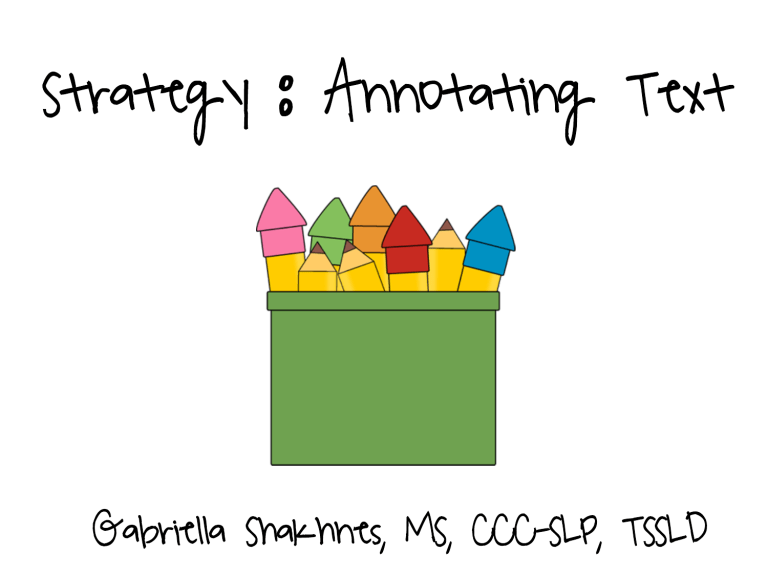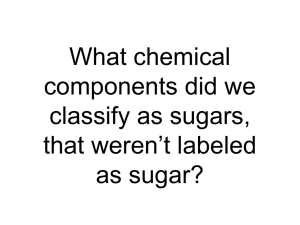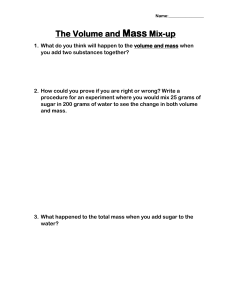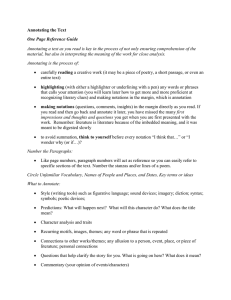Annotating Text: A Strategy for Better Reading Comprehension
advertisement

Strategy : Annotating Text Gabriella Shakhnes, MS, CCC-SLP, TSSLD What is Annotating? • Annotating is simply taking notes about what you’re reading. It is a 1-3 sentence summary of what you just read! • Annotating means writing about the text, either in the margins or on post-its. • Annotating helps you better understand what you read. In addition, it helps you think about the reading and allows you to comment on important details. • Annotating can also be used as a reference when you want to go to a specific paragraph. Examples of Annotating Doctors say that spending too much time online can have consequences. Spending too much time online can cause violence, cyberbullying, school woes, obesity, lack of sleep, and other problems. Doctors 2 parents: Limit kids' tweeting, texting & keep smartphones, laptops out of bedrooms. The recommendations are bound to prompt eye-rolling and LOLs from many teens, but an important pediatricians group says parents need to know that unrestricted media use can have serious consequences. It's been linked with violence, cyberbullying, school woes, obesity, lack of sleep and a host of other problems. It's not a major cause of these troubles, but "many parents are clueless" about the profound impact media exposure can have on their children, said Dr. Victor Strasburger. He is the lead author of the new American Academy of Pediatrics policy. Examples of Annotating Two-Hour internet limit includes the use of all entertainment outlets. Under the new policy, those two hours include using the Internet for entertainment, including Facebook, Twitter, TV and movies; online homework is an exception. Reports show that kids spend more then 7 hours a day using some kind of media. Kids may spend that time doing inappropriate things. The policy statement cites a 2010 report that found U.S. children aged 8 to 18 spend an average of more than seven hours daily using some kind of entertainment media. Many kids now watch TV online and many send text messages from their bedrooms after "lights out." Some of the messages are sexually explicit images sent by cellphone or Internet. Still, few parents set rules about media use, the policy says. Your Turn! We live in a sweet world. The average American kid consumes more than 20 teaspoons of sugar per day, and adults eat 50% more sugar today than they did in the 1970s. We all know that too much sugar isn’t good for you. But did we know it could be toxic? A team of researchers at the University of Utah used mice to conduct a study on the negative effects of sugar. They found it could have serious effects on people’s health. During the 58-week-long study, mice were fed a diet containing 25% more sugar. This percentage is equivalent to a healthy human diet along with three cans of soda daily. The team found that these mice were twice as likely to die compared to the mice fed a similar diet without the sugar. Your Turn! Scientists often use mice for research because they have a similar genetic structure to humans. “Since most substances that are harmful to mice are also harmful in people, it’s likely that what caused those mice to have increased death rates, can also have an effect in people,” says study author James Ruff of the University of Utah. Different types of sugar have different effects on the human body. Some of the sugar we consume comes from foods we might expect— candy, soda, and cookies. But much of the sugar that we eat is hidden. Food companies add large amounts of sugar to items such as pasta sauces, crackers, and even ketchup. To help cut down on extra sugar, nutrition experts suggest looking at the ingredients on food packages.


